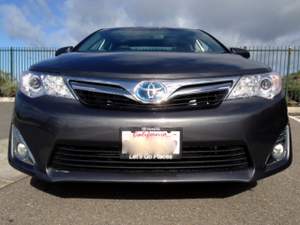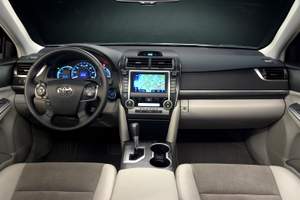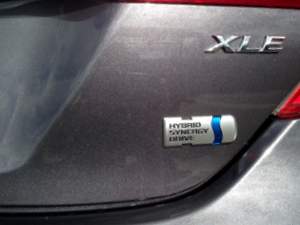Camry Quality and Reliability with Increased Fuel Efficiency
What possibly could Toyota do to improve the Camry, which was the #1 selling midsize car in the U.S. in 2013 (and for several years previous)? How about offering a version with their proven hybrid technology that increases the horsepower and fuel economy? It makes sense adding the Camry to their hybrid (which they did in the 2007 model year) line-up since Toyota, led by their four-model Prius family, is the top seller of hybrid powered cars. They hold 2/3rds of the hybrid market with 11 Toyota and Lexus models 14 years after introducing the Prius here; the Camry Hybrid usually holds down the #2 sales spot among hybrids. They pretty much have hybrid technology figured out.
Drivetrain
The front-wheel drive 2014 Camry Hybrid is powered by Toyota’s Hybrid Synergy Drive system which combines a 2.5L, 16-valve double-overhead-cam (DOHC) gasoline-powered, in-line 4-cylinder engine and a 105-kW electric motor with a nickel-metal hydride battery (Ni-MH) to store electrical power. The two power sources produce a combined peak output of 200 hp and 156 lb-ft of torque through a very smooth Electronic Continuous Variable Transmission, or ECVT.
Fuel economy for the 2014 Camry Hybrid is rated at 38 highway/40 city with a combined of 40 mpg. Running on regular unleaded, I drove 365 mostly highway miles and averaged 40 mpg but did not come close to using all 17 gallons in the tank. At my fuel consumption rate I could have traveled almost 700 miles.

To maximize fuel economy, Toyota’s Hybrid Synergy Drive automatically switches between the electric drive mode, combined electric and gasoline engine (hybrid) mode and only engine power. The transitions are seamless and smooth and can be monitored by viewing the dash gauges.
The Camry Hybrid has an Eco mode button that improves fuel economy and an auto-stop feature that temporarily turns off the engine to save fuel when you come to a stop. Taking your foot off the brake pedal automatically restarts the engine.
The nickel-metal hydride battery is charged by the engine and through the regenerative charging system, which converts kinetic energy into electric energy and stores it in the battery when applying the brakes or coasting. This process is also viewed on a dash gauge where you can watch the power flow into and out of the battery and engine.
Driving Experience: On The Road
The Camry Hybrid weighs in at a solid 3,545 lbs. which is 330 lbs. more than the gasoline-powered, base model Camry L. The weight comes from options on the XLE plus the hybrid components, primarily the battery.
The CVT has one primary drive gear and for additional charging of the battery for EV driving, a “B” mode which acts like an engine brake. The Eco mode reduces horsepower but is easily over-ridden when needing to accelerate to change lanes or pass cars and trucks.

For those of you that have never driven a CVT, you should give it a try. I like them for their smooth operation–never feeling a gear shift–and increased fuel economy. As auto manufacturers constantly search for ways to boost fuel economy more will be introducing the CVT into their vehicles.
The Camry Hybrid XLE comes with 17-inch alloy wheels and all-season tires, electrically power-assisted rack-and-pinion steering with front MacPherson struts and stabilizer bar, and dual-link rear MacPherson struts with a stabilizer bar. All this delivers a confident, smooth and quiet highway ride, but I would have liked more steering feel. Tight cornering produces some body roll, which is to be expected for a vehicle of this weight, particularly one that is not designed to be a sports sedan.
The Camry Hybrid ran about 9 seconds from 0 – 60, which, for a midsize sedan, is very respectable. Where the hybrid system
produces the best acceleration is at freeway speeds when passing or changing lanes. If you need to go from 65 to 75 the Camry Hybrid gets that done quickly and smoothly. The CVT finds the right powerband and off you go without feeling a gear shift.
But going fast is worthless if you can’t stop – just ask any racer which they would rather have, a few more horsepower or better brakes. The Camry Hybrid comes with power-assisted disc brakes with ABS, which are part of Toyota’s Integrated Regenerative Braking system. I found the stops to be straight and consistent, which is important to build confidence for emergency stopping. There was no brake grab which can be common on less sophisticated regenerative braking systems. When coming to a stop the combination of the regenerative braking and the hybrid motor made a considerable whine, which became annoying in city driving.
Driving Experience: Interior
Clean Fleet Report was driving the fully optioned and nicely appointed Camry Hybrid XLE. The XLE package included power eight-way adjustable, heated driver and four-way adjustable heated passenger seats, which were leather-trimmed with Ultrasuede inserts. The Ultrasuede had a nice feel and touch, but in a family car could lead to stains. Finding a comfortable seating position was not difficult and except for the high rear deck lid compromising a bit of the rear view, the sight lines were excellent.
The cockpit design is driver friendly with all the gauges in easy sight and controls within easy reach, including many on the steering wheel, with the audio and navigation found centered in the center stack.

Our car had the optional Convenience Package that includes everything you would expect – or want – in an entertainment system. The list is long but the cornerstone is Toyota’s Entune Premium JBL Audio with Navigation that includes a 7-inch high-resolution split-screen touch-screen display, AM/FM CD player with MP3/WMA playback capability, 10 JBL GreenEdge speakers, including a subwoofer and amplifier. There is an auxiliary audio jack, USB port with iPod 6 connectivity, music streaming via Bluetooth wireless technology, SiriusXM and HD Radio. Toyota’s voice recognition and hands-free phone capability worked well with no significant learning curve. What I really enjoyed was the AM/FM radio and its ability to cache programming (keeping the last 20 minutes of programming for playback). This is a very cool feature that I wish more manufacturers would include on their top-end entertainment packages.
But what is all the comfort and convenience worth if the car isn’t safe? The Camry Hybrid is well equipped with active and passive safety features including 10 air bags, remote keyless entry, power door locks, TPMS (Tire Pressure Monitoring System), projector beam headlights, adaptive cruise control, integrated back-up camera, collision sensors, blind spot monitoring, cross-traffic alert, anti-theft alarm, an energy-absorbing collapsible steering column and the previously mentioned four-wheel disc brakes with ABS, stability assist with traction control and electronic brake distribution.
Pricing
The 2014.5 Camry Hybrid XLE Clean Fleet Report was driving had a price of $34,610, including the $810 Delivery Processing and Handling Fee, which other car manufacturers call the Destination Charge.
The 2014.5 Camry Hybrid comes in three models, but can be ordered with Option Packages that will affect your final price. The base MSRP for the three models, including the $810 Delivery Processing and Handling Fee:
LE $26,330
SE Limited edition $27,945
XLE $28,625
Pricing for the Hybrid model represents a premium of $3,460, $4,205 and $2,815 for the three models (LE, SE, XLE, respectively). Of course the Hybrid model doesn’t have the entry-level L model the standard Camry does, which would represent another $445 discount.
The 2014.5 Camry Hybrid comes with these warranties:
• 3 year/36,000 mile – Basic
• 5 year/60,000 mile – Powertrain
• 15 year/150,000 – Hybrid-related Component Coverage for: California, Connecticut, Delaware, Maine, Maryland, Massachusetts, New Jersey, New York, Rhode Island and Vermont
• 8 year/100,000 mile – Hybrid-related Component Coverage for all states not listed above
• 5 year/Unlimited miles – Rust-through (corrosion perforation of sheet metal)
Observations: 2014.5 Toyota Camry Hybrid XLE
Do you have a need to sit up to five adults and like the thought of getting 40+ miles per gallon while doing so? If so, the 2014.5 Toyota Camry Hybrid, whether it is the LE, SE or XLE versions, you will be doing so in comfort, with respectable performance and a high level of safety and reliability.

The midsize sedan category is the most competitive and Toyota knows they have to continue to improve the Camry if they want to remain the sales leader, which of course is good news for consumers. Improvements in automotive technology, whether focused on fuel consumption, safety or conveniences, make driving just that much more fun.
Whatever you end up buying, enjoy your new car and as always, Happy Driving!
Story and Photos by John Faulkner
Related stories you might enjoy on some of Camry’s competition:
Road Test: 2014 Toyota Avalon Hybrid—Camry’s Big Brother
Road Test: 2014 Honda Accord Hybrid—Fun But Responsible
Overview: 2014 Chevy Malibu With Start-Stop—Standard Fuel Economy
Overview: 2014 Ford Fusion With Start-Stop—Fuel Economy Boost

12 thoughts on “Road Test: 2014 Toyota Camry Hybrid XLE Premium”